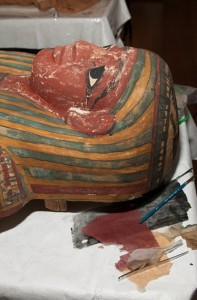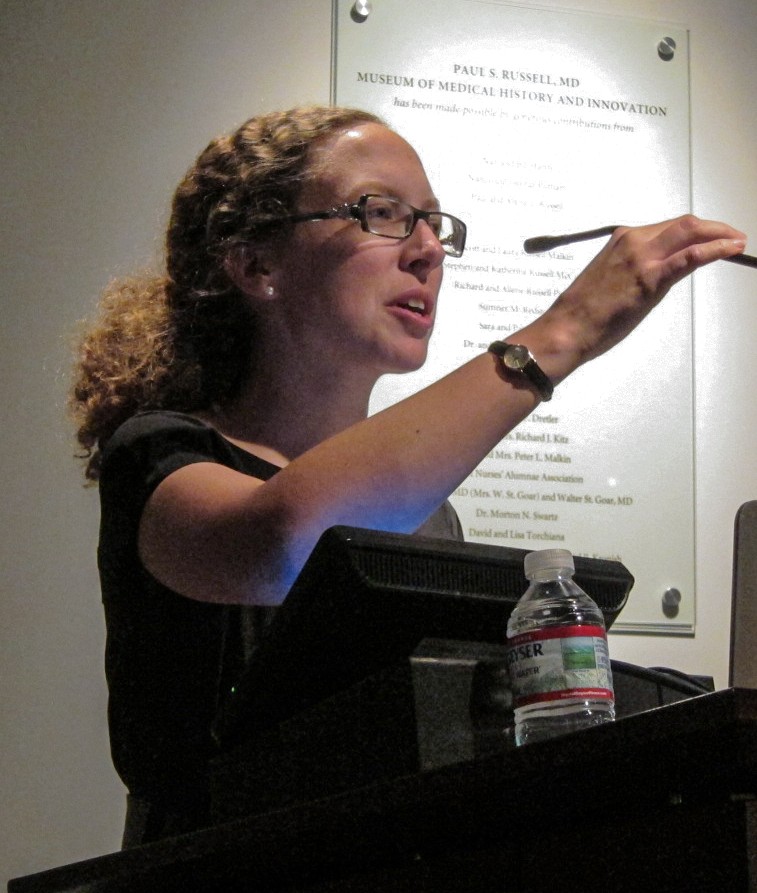By Sarah Alger (Regular Contributor)
When, in the early 1800s, a patient was brought into the surgical amphitheater at Massachusetts General Hospital, he or she was likely blinded by the terror of undergoing surgery fully conscious. Yet had the patient looked around, while being lashed to a chair, he or she might have taken in the cupola and louvered windows admitting the morning sun; a gathering of physicians, medical students and other onlookers in the tiered seats; the surgeon preparing his instruments; and a pair of upright glass-fronted cases, one containing an Egyptian mummy coffin, and the other, the mummy himself.

Padihershef and his inner coffin underwent extensive conservation in 2013.
How did the mummy come to be there? In 1823 he was given by a Dutch merchant to the city of Boston, which in turn gave him to the hospital for fundraising purposes. The hospital duly shipped out the mummy for a tour of the Eastern seaboard, reaching as far south as Charleston. People paid 25 cents to see the mummy, the first complete Egyptian burial ensemble in the United States. In 1824 he returned to the hospital, where the trustees deemed him “an appropriate ornament of the operating room.”
Head surgeon and hospital co-founder John Collins Warren was the first of many at the hospital to explore the mummy’s mysteries. In the operating room before a crowd, Warren cut away the wrappings around the head, but chose to go no further, instead visually inspecting the rest of the body and the inner and outer coffins, and going on to publish a detailed description in the Boston Journal of Philosophy and the Arts. Warren surmised that the man had been a priest, but much mystery remained.
It was not until 1960, when an Egyptologist at the Museum of Fine Arts examined the coffins’ hieroglyphics, that the mummy’s name was revealed: Padihershef, meaning “gift of the god Hershef.”
As imaging technology came into existence and advanced, so it was applied to Padihershef. He was first X-rayed in 1931, then in 1976. During that later session, radiologists discovered some neck vertebrae missing, leading them to wonder how the mummy’s head was staying on. In 2013, when Padihershef underwent extensive conservation and CT imaging, it was discovered that a broom handle was holding his head on, a fix attributed to a conservator in 1984 at another museum, where Padihershef resided for a while.
Egyptologist Jonathan Elias analyzed Padi after the 2013 conservation, and though his report holds a number of fascinating observations, perhaps the most evocative one is about Padihershef’s occupation. He was not a priest, but rather, according to the hieroglyphics, a stone mason:
“On balance, our general interpretation of his occupation must move away from heavy manual activity in the field of ‘stone masonry,’ and any images conjured up by that term. We should begin to view Padihershef instead as a sort of prospector amongst the tombs in western Thebes, and as the kind of person who would scramble up and down the rocky slopes of the Theban necropolis in an effort to identify opportunities to carve out fresh burial space amidst the myriad empty chambers, crags and crevices.”
It is now this image I’ll hold when I regard Padihershef, who still watches over our original operating room.
Sarah Alger is our newest Regular Contributor at Wonders & Marvels and she will be writing our new column Museum Mysteries. She is the director of the Paul S. Russell, MD Museum of Medical History and Innovation at Massachusetts General Hospital. She is also senior editor of Proto, a Mass General-sponsored magazine that covers new ideas in basic and clinical research, health policy and technology the world over. She tweets as @slodoena.

